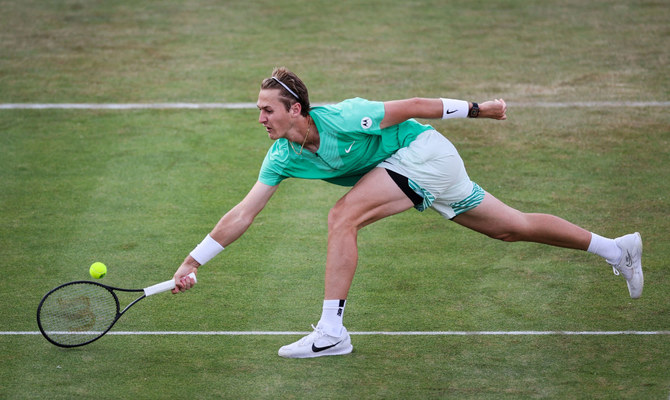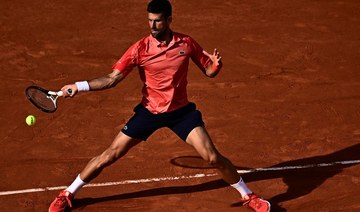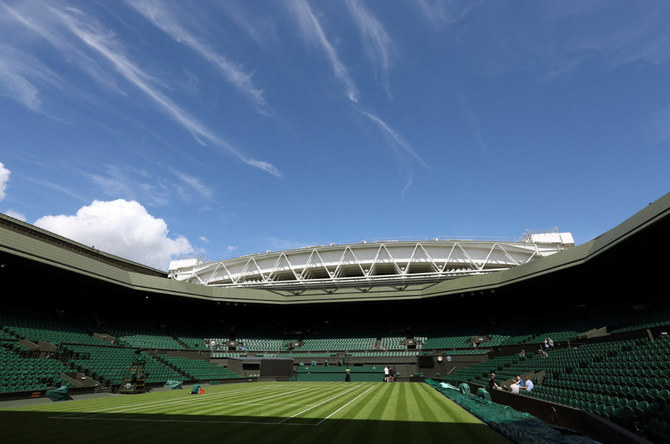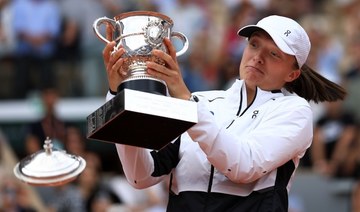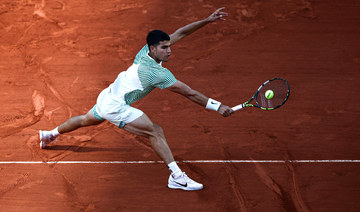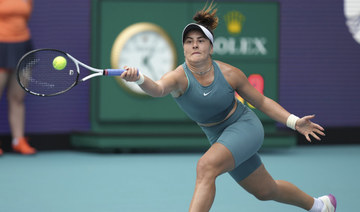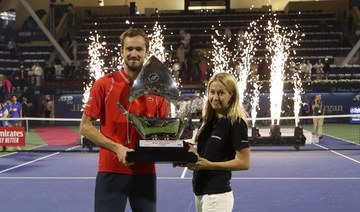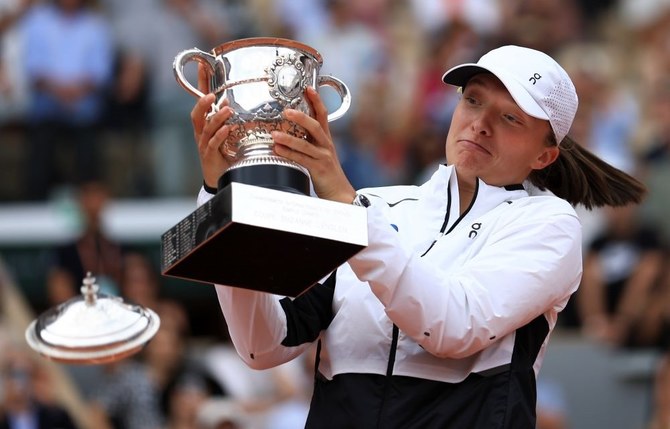As Iga Swiatek navigated her way to a third Roland Garros crown, and fourth Grand Slam trophy overall, earlier this month, the 22-year-old Pole felt like “the whole world was watching” her.
Not only did she feel she had to live up to her title-favorite status on her beloved clay, Swiatek also had to fend off Aryna Sabalenka, who could have replaced her at the top of the rankings had the Belarusian matched her result in Paris, or gone one better.
It was perhaps the most pressure Swiatek had felt on the major stage and she passed the test with flying colors, dropping just one set en route to lifting the Coupe Suzanne-Lenglen.
Her record at the French Open now stands at a remarkable 28-2 (93 percent) and she is 63-9 lifetime on clay at tour level.
On Monday, Swiatek begins her 64th consecutive week as the world No.1 and can approach the grass season with far less pressure on her shoulders. Despite winning the Wimbledon junior title in 2018, Swiatek confesses she has limited experience on grass, which is reflected in her modest 6-5 win-loss record on the surface in main draw matches at tour level.
Less pressure at Wimbledon?
Her entire grass-court experience on the professional tour amounts to less than half the number of victories she has collected at Roland Garros alone.
In a small roundtable interview following her triumph on Parisian clay last Saturday, Swiatek discussed her approach for the grass-court swing and Wimbledon.
“Basically before every grass-court season I just want to keep being openminded and just learn a lot,” said Swiatek, whose best Wimbledon result was a fourth-round showing in 2021.
“I feel like there is maybe a little bit less pressure, but on the other hand when I just go on court, I feel like I know how I can play tennis and I know how I can play on other surfaces.
“On grass sometimes it’s tougher and I still have to learn a lot, but I just feel like you’re going to go on court and not play the way you should or the way you could; so this thing is adding more pressure.
“But I would say that the pressure from the outside, yes it’s maybe a little bit less, it depends on you guys and what questions you ask,” she added, referring to the weight of expectations often placed on her by the media.
The grass season is only five weeks each year, and for a top player like Swiatek, who typically goes deep at the French Open and needs some extra rest after the clay, it can only mean two tournaments — a warm-up event and Wimbledon.
Swiatek is scheduled to play in the WTA event in Bad Homburg, Germany, next week (begins June 26) before heading to southwest London and is aware there are limited opportunities to get comfortable on grass.
“Maybe there’s going to be a chance to play more matches,” she said. “But I’m pretty sure that still when I’m going to play these matches, I’m going to feel a little bit uncomfortable. But I also trust that every year I’m going to learn more and more and I’m going to progress anyway. But it’s a short season, only three weeks, so the challenge is tough.”
‘Staying consistent is a great achievement’
This week, Swiatek has tied Simona Halep in 11th place on the WTA leaderboard for most weeks spent at the summit of the rankings.
Since she took over the top spot, on April 4, 2022, in the wake of Ashleigh Barty’s sudden retirement last year, Swiatek has been a consistent force on tour. As a world No.1, she has added eight more trophies to her cabinet, to take her total to 14, at times barely dropping games, let alone sets, on her way to the champion’s podium.
Still, within this consistent 15-month period, Swiatek has also faced varying degrees of challenges, be it from the outside or within.
Last season, her points tally was more than double of what her closest rival possessed. Two weeks ago, her margin was so slim that she was within one defeat of losing her No.1 ranking.
Last season, she seemed untouchable. This campaign, Australian Open winner Sabalenka and reigning Wimbledon champion Elena Rybakina have upped the ante and made a case for the rise of a “Big Three” in women’s tennis.
“I would say at the beginning of the season this year I felt like in Australia I should play better as a world No.1 and reach further rounds, and it wasn’t easy for me back then to cut it out and just play the game of tennis and enjoy it,” she said.
“Last year I didn’t really feel like I was being chased because I felt like all the things that are happening were so new that I was just focusing on achieving.
“That’s what I also tried to do after Australia this year and I think it’s working.
“Even though the difference in points is smaller (between myself and the world No.2), I feel like it’s a great achievement for me to keep a consistent level with all that pressure. Because there is pressure; and you can see it on social media and everything.”
A three-way rivalry?
Throughout Roland Garros, Swiatek was regularly fielding questions about Sabalenka and Rybakina closing in on her and was not too keen to indulge discussions of a new “Big Three.”
“Last year I wasn’t even asked about other players and this year I’m asked basically in every press conference a couple of times, even though they’re on the other side of the draw, there’s nothing really connecting us in this tournament — there’s always something around that’s implying that things are different,” she said.
“But you always have to come back to what it is you want to achieve because it has nothing to do with other players, even rankings sometimes. Because you want to win matches and tournaments, and rankings go up after that.”
After a historic 2022 season, Swiatek says she went home to Raszyn, Poland, and “went on the Internet too much maybe.”
“I read a lot, because I thought it was going to help me process what happened and close the season and start a new one, but maybe reading all that stuff actually, it was my idea, but it wasn’t the best idea,” she said.
After defeating Karolina Muchova in three close sets to reign supreme in Paris one more time, Swiatek said she “will never doubt my strength again,” given everything she overcame to secure the victory, including a thigh injury she picked up in Rome a week before the French Open.
The world No.1 also said she does not think too much about what she is capable of achieving in the sport.
“I don’t think I need any idea, I’ll just go forward. My whole career, if you’re talking about wins, I’ll try to win as much as possible obviously but I’ll try to develop as a player. I don’t think we all know what our limits are, unless we’re done and we’re really mature, but I’m 22, so I just really don’t know where my limits are,” she said.


